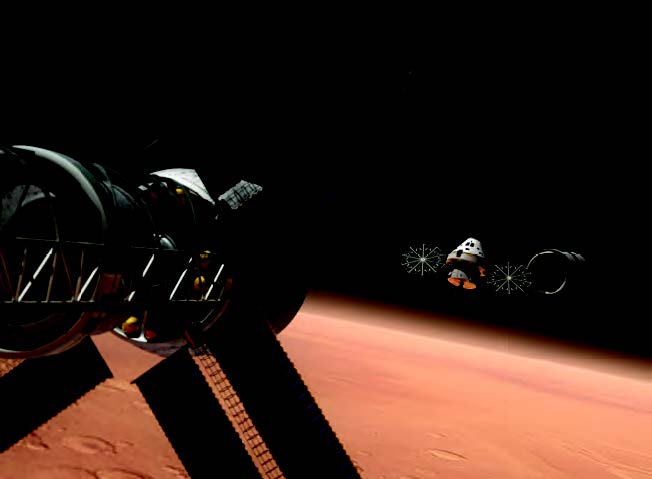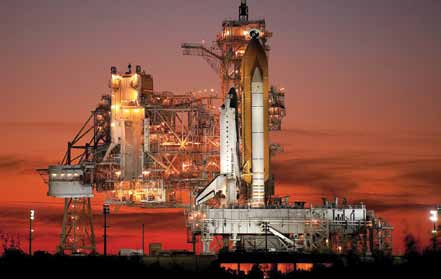
Visions of Government in 2040: Perspectives on the Future -- A Report from Mars

In the IBM Center’s new book, Government For The Future: Reflection and Vision for Tomorrow’ Leaders, part two of the book looks twenty years ahead offering perspectives on the future. This contribution is the first in a five-part series beginning with a dispatch from the Mars Exploration Base, Stardate July 20, 2039, authored by W. Henry Lambright.
We have landed on Mars and have established our Mars exploration base. We landed today, the 70th anniversary of the Apollo 11 Moon landing by the U.S. in 1969. Let us tell you how we got to Mars and how the Mars 2039 mission differed dramatically from the way the U.S. reached the Moon in 1969.
Our Mars Together Project, as it is called, involves space agencies from the U.S., Russia, China, Canada, Europe, Japan, Korea, India, and other nations. It is undergirded by hundreds of private sector and university partners, comprising thousands of scientific researchers from all over the world. The private sector partners are not only involved as contractors, but share in the costs of the project.
A collaborative governance model was used to get us to Mars and to effectively deploy the expertise that was assembled for our Mars mission. The Mars Together Project is a strong contrast to the NASA-dominant Apollo model. Our Mars mission is a logical extension of collaborative programs that began with the International Space Station (ISS) and were succeeded in the late 2020’s and 2030’s by a global project to build a base on the Moon.
Along the way, government and private sector companies found incentives to cooperate to explore the universe. Public interest in Mars was stimulated by unmanned soil-sample returns to Earth indicating strongly that Mars once had or still had life. In the past decade, the 2030s, human spaceflight and robotic technology merged in the interest of exploration.
The path to Mars can be traced over three critical phases described below. Each phase outlines the key building blocks -- successes and failures -- that made this collaborative effort possible.
What did it take to get to Mars? What made collaboration among nations, and between nations and the private sector, successful? The past was our guide to the present, 2039, and the past showed us examples of false starts, mixed results, and successes.
False Starts
- In 1969, after the Apollo landing, NASA pushed for a comprehensive human space flight program that included Mars missions as early as the 1980s. President Nixon rejected this proposal.
- In 1989, President George H. W. Bush proposed a Space Exploration Initiative to return astronauts to the Moon and then advance to Mars. When the possible cost of such a program leaked, Congress refused to fund the effort. It was aborted.
Mixed Results
- In 2004, President George W. Bush announced his Vision for Space Exploration plan, along with Project Constellation. Vision for Space Exploration. It got underway.
- In February 2010, President Barack Obama terminated it. Obama substituted an asteroid mission for Bush’s goal of a Moon landing, and called for reaching Mars in the mid-2030s.
- In 2018, President Trump ended the asteroid mission, and brought back a mission to the Moon with Mars the ultimate objective.
- The European Space Agency (ESA) pursued the ExoMars project to mixed results. This was a robotic program designed in the Obama years to help answer the question of life on Mars. U.S. dropped out of the partnership as a lead funder owing to domestic budget troubles
Successes
- The International Space Station was a “next logical step” beyond the shuttle. ISS achieved “assembly complete” in 2011, and continued in operations during the decade of the 2020s. ISS served as a model of collaborative partnership for us in which the U.S served a “managing partner” role of an enterprise embracing five space agencies and fifteen sovereign nations.
- Another key step to Mars was the “roadmap” to Mars published in 2018 by the International Space Exploration Coordination Group (ISECG). The ISECG’s 2018 “Global Exploration Roadmap” was a technical roadmap, not a political or administrative design. The roadmap was consistent with then-US policy that made the Moon—a lunar base in particular—a key interim step
Becoming More Collaborative (2018-2030)
Following planning, in 2022 a group of nations and private sector companies agreed to create the Mars Together Project with a 2039 landing goal. Crucial to the success of this effort were key decisions on who does what, how, why, and when. The participants assumed (correctly) that NASA and other partners would accompany flight missions to the Moon and Mars with rigorous research and development to create new technologies to speed transport, bring down costs, and increase safety. For example, in-space propulsion technologies, were necessary, along with technologies enabling human stays on the Moon and Mars.
Policy shifts were made in the 2020s. The U.S. ended its role on the International Space Station and diverted funds to the Moon and beyond. During this decade, NASA relinquished its leadership in low-Earth orbital flights, and begin to move more aggressively toward the Moon and Mars in preparation for the 2030s.
Due to its age, the International Space Station mission ended in the late 2020s. Starting in the 2020s, newer, smaller space stations were launched and run by the private sector and other nations.
The U.S. and NASA, in partnership with other nations and the private sector, began a robotic presence on and around the Moon in the late 2020s. The U.S. and China, previously rivals, furthered mutual exploration goals as partners throughout the late 2020s and early 2030s.
Exploring the Moon in Preparation for Our Trip to Mars (2030-2039)
During the decade of the 2020s, NASA and its partners built a small space station to go around the Moon as a step between the International Space Station and a Moon base. This outpost continued the International Space Station’s function of studying how humans adapted to journeys away from Earth. The lunar outpost was 250,000 miles away, in contrast to the ISS’s 250 miles, and astronaut stays exceeded one year. We were breaking the umbilical cord to Earth.
Our next step toward Mars, in the early 2030s, was to land and operate on the lunar surface. Given its minimal gravity, the Moon served as an ideal point of embarkation to Mars for humans and supplies. As with the International Space Station, NASA needed to pioneer, develop, and avoid becoming an “operating” organization on the Moon. The Red Planet was our goal.With the Mars Together Project in place in the early 2030s, full attention was given to landing on Mars.
Success Factors in our Trip to Mars
The Mars Together Project, declared in 2022, has reached its goal of landing on Mars. What critical factors brought our mission to its successful landing on Mars?
- Success Factor One: Collaborative partnership and leadership. Collaboration embraced many nations and private companies. The overall “managing partner” was the U.S. and NASA. Senior partner status was based on who invested the most money and personnel in the project, and who took the greatest risks in moving outward towards Mars. Partners made policy mainly through consensus—using a “heads of organizations” committee. The Mars Together Project coalition had decided on roles and authority at the outset of the project. There were disagreements, but partners worked through them.
- Success Factor Two: Inclusive partnership. Members of the project included all International Space Station partners plus additional nations and the private sector. It took time to bring China aboard, but China joined at the lunar-landing stage in spite of political opposition in the U.S. and China was going to go to the Moon and Mars eventually and was already investing more money and talent in doing so than any other nation aside from the U.S. It was better for all if China was part of the project team to share costs and risks. NASA, as project catalyst, kept its aim on the goal. It led in developing capabilities, deploying hardware, using that hardware, and then relinquishing control as it advanced to the next step. Others took over operations of each specific milestone.
- Success Factor Three: Interdependence. What motivated the partners to stay together was the realization that so ambitious a goal—a Mars landing in 2039—required multi-institutional cooperation. There was no practical alternative given financial realities. This meant a division of labor in which different organizations took the lead in different facets of the project. The partners in the Mars Together Project established goals and division of labor at the outset and sustained both throughout the project. Trust and transparency were observed. The US, as collaborative leader, made choices openly and distributed information to all members of the team as soon as possible whenever possible. It exercised “power with,” not “power over.”
- Success Factor Four: Personal relationships and project cohesion. These factors developed among national and private sector participants. Cooperation involves people. The heads of organizations who served for long periods of time developed personal rapport. Political skills also proved crucial. This domestic-international maneuvering required not only political and managerial skill, but diplomatic talents of a high order. Given the length of the project, a succession of NASA administrators demonstrated such political, managerial, and diplomatic skills. It was necessary to buffer the project from internal and external forces.
The success factors discussed above took the Mars Together Project from a concept to a launch to the Martian surface. The project required nations, government agencies, and private sector companies to think big and “outside the box” about ends and means.





